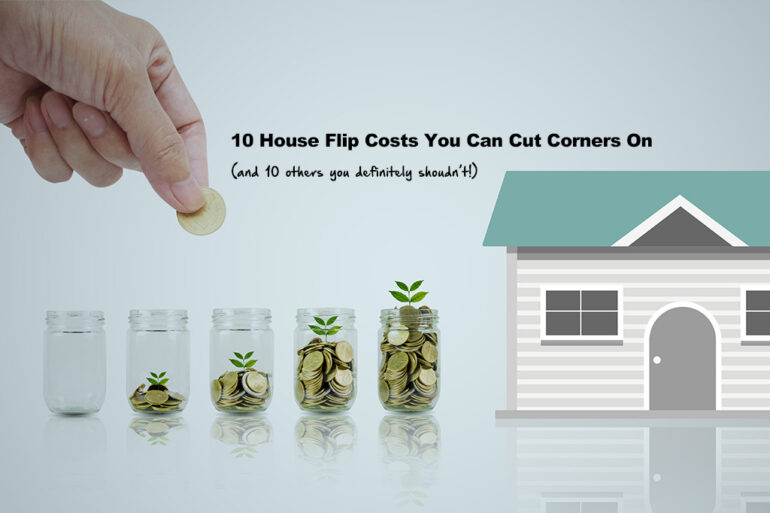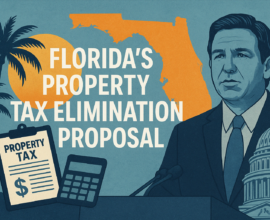10 House Flip Costs You Can Cut Corners on but These 10 You Shouldn’t!
Whether deals are abundant or scarce, it is always the goal of the investor to buy low and sell high. In the current market, it is more imperative than ever to make the most of a potential flip. At the same time, families and individuals will be living in these houses, and their safety and enjoyment of their homes are an utmost priority.
There are some concepts that may take precedence over others in your budget. There are other renovations that seem lucrative but may add no value to your home at all. How you plan your budget and strategy will depend on many factors, including location and demographic.
A grab bar in the shower may make no sense at all in a young and trendy neighborhood but may make all the difference in a senior citizen–friendly condominium. It is important to do your own research and due diligence before you begin your flip. After thorough market data analysis on comparable properties, you should have a good idea as to what renovations will best serve your project.
A popular rule of thumb for house flippers is the “70% Rule.” This rule dictates that the original cost of the home should not be more than 70% of the after repair value, minus the costs of the repairs. Using this rule may ensure that future cost-saving measures will be effective by locking down your profit on the other side of the equation.
Once you have purchased the home at a low cost, there are additional ways to keep costs down as you begin renovations. Knowing ahead of time what areas not to pour your resources into could save you a fortune.
10 Upgrades and Repairs You Can Cheap Out On
1. Trends
It is hard to resist the appeal of duplicating the current aesthetics on Instagram. There are some truly innovative styles that many of us would love to recreate with our own personal interpretations. However, if you want to get the highest possible profit out of your flip, you should stick to a look that is classic and timeless.
Save the bold and crazy new ideas to try out in your own residence. There was once a time when shag carpet and lime green toilets were the height of home fashion. Keeping things simple will significantly broaden your list of potential buyers. They may have their own ideas for interior design, so keeping the look neutral will allow them to envision their own plans.
2. Replacements
When walking into a dilapidated room, it can be tempting to want to clear everything out, haul it away, and have a fresh start. However, according to TheSpruce.com, refacing cabinets instead of replacing them can save as much as 50%. The same is true for many other features of a home.
A tub could be refinished for about $400 and look brand new. On the other hand, replacing the tub, redoing the plumbing and tile, and paying for labor could cost you upwards of $1,000 for the exact same result.
When evaluating a potential issue, it is important to determine what would address the concern with the most reasonable amount of cost. If parts of the home are salvageable, it will save money in the long run to work with what you have available. As long as everything looks clean and uniform and functions well, there is no reason to tear everything out and start again.
3. Countertops
While new countertops can raise the value of a property, it is not always wise to install the more expensive types. Pricey countertops tend to be the most difficult to maintain, and every buyer will have their own preferences on material.
Marble, for example, can require frequent sealing and other maintenance. The most important thing is that the countertops are clean, undamaged, and not appearing as if from a different era.
If the countertops are workable, it is possible that they can be refinished or even repaired. If they are an eyesore, they can be replaced with the material that you can afford based on your budget. Ceramic tile countertops are more affordable than many other options and are easier to install.
4. Pools
Adding a pool may generally increase the value of the home if the pool is in ground (above-ground pools can have the opposite effect) but it is not likely to recoup the full cost of installing it. Post–COVID-19, there seems to be an uptick in the value of pools and they can add over $100,000 to your home’s value. However, it remains to be seen whether this is a temporary trend.
Pools are a great source of entertainment, especially for families who are unable to go anywhere else. Their value is increased right now, but what happens when/if the pandemic is manageable and the world goes back to normal?
For some demographics, it can reduce your prospective buyers. Those who do not want to worry themselves with the upkeep of a swimming pool may not want to view your property at all.
Location can make a large difference. In Florida and other warmer states, there is more demand for swimming pools. However, in northern states, where they can only be used for part of the year and require more maintenance, they are less likely to attract buyers even if they do add value.
If the home you are flipping already has a pool, it could be worthwhile to get it fixed up rather than removing it. However, if you are thinking of adding one, consider if the resources may be better used elsewhere in the project.
5. Creating Larger Rooms from Smaller Rooms
While adding space in the home is a key strategy to maximizing revenue, do not implement this tactic at the expense of additional bedrooms. When it comes to attracting buyers, it is better to have more bedrooms. Having fewer bedrooms could result in a reduction of interest from buyers who need a certain number of bedrooms.
Even if a family of four only needs a three bedroom, now more than ever people want home offices. Leave as many rooms as possible and focus the money you would have spent knocking down walls on making all the bedrooms seem more spacious.
6. Expensive Fixtures
Unless you are selling luxury homes, there is no need to spend thousands on a chandelier and high-end faucets when hundreds could provide the same quality functions. Functionality is more important to most buyers than vanity.
Pricier fixtures require more intricate cleaning, repairs, and maintenance. Fancy versions often only appeal to a few people who share your same tastes. While expensive materials may add value, it could scare away buyers who want something less ostentatious.
7. Wallpaper
Wallpaper can be a nuisance when flipping a house as the original material is often outdated and in rough shape. It can peel, take on moisture, bubble, and turn various shades of dingy brown, which will add to your workload.
If there is already unappealing wallpaper in the home, it can be a herculean task to remove it but it’s a worthwhile project. If there is no wallpaper when you acquire the house, you certainly do not need to purchase some.
Although wallpaper is back in vogue right now, painting can be cheaper and offer you an equal range in creativity. You can choose from a variety of colors and shades, and if you want to make a space extra eye-catching, you can use sponges, stencils, and decals to achieve great results.
If you want to participate in the current wallpaper trends, consider painting most of the room but wallpapering just one strategic accent wall. Be sure to keep the color and pattern of the walls classic enough to appeal to most buyers.
8. Over Improvement
The value of your property is based on many factors, and a key determiner is location. Once you have purchased the home, to an extent your control of the value has been limited. You can improve the value of the property but not the location. Pouring money into upgrades and even increasing square footage may not yield a good return if you have not done “comps” on the other houses in the neighborhood.
Market data analysis should give you a good idea as to what houses in your neighborhood with similar sizes and features are worth. Base your ideas for renovations on these numbers. Ideally, do this research before you buy the property!
9. The Backyard
It is important that the backyard is neatly mowed and there are no eyesores. Time and resources should be spent to make that happen, but be cautious not to focus too much on this area. While in many cases a beautiful garden in the backyard may appeal to buyers, landscaping that goes above and beyond may be intimidating.
According to LawnStarter.com, large concrete patios, water fountains, and specialized décor can detract from the overall value. A meticulously designed landscape in the backyard may add some value to your home, but the cost is unlikely to be recouped in the sale.
10. Hobby Spaces
While extra rooms add value, it would be wise to keep the purpose of these rooms up to the buyer’s imagination. Home gyms, sewing rooms, and offices are all possible uses of the rooms, but without knowing specifically who may be interested, avoid making any major modifications for niche purposes. HomesAndGardens.com advises against wine cellars for this reason.
The idea is to suit the home to the broadest possible market. Instead of adding renovations for your own interpretation of what the room will function as, leave the purpose vague so that the buyer can envision their home office, gym, or whatever they need.
There are always areas in the budget that have a bit of wiggle room, and that is especially true for cosmetic and aesthetic features of a house flip. But there are some corners that should never be cut. This is essential for the health and safety of the families who will be living in the home. There are ways to be frugal but never at the expense of personal welfare, ethics, and your reputation. Here are some areas that you should prioritize in your budget.
10 Upgrades and Repairs You Cannot Cheap Out On
1. Plumbing and Electric
Despite an abundance of YouTube tutorials taught by certified experts, there are simply some things you should not DIY. It can be very tempting. When you have watched videos and read up on how to ground the electric in the house, you feel like it is a colossal waste of funds to hire an electrician. It is not.
Should you be successful in doing the project on your own, you still may have missed something that an expert would have noticed that could cause serious problems for your buyers in the future. By serious, I am referring to floods and fires, which could be life-ruining. Why take that chance?
In many states, only professional plumbers and electricians are allowed to work on these things, though the laws can vary by state depending on if you are the homeowner. Allow plenty of room in your budget for these areas to be inspected and repaired by licensed professionals.
Be sure that any contractors who are not licensed in these areas also avoid the plumbing and electric, no matter how adamant they are that they can do it just as professionally and for a reduced price. The cost of being cheap could be very high if you are not cautious.
2. Inspection
The inspector will be able to save you money in the long run by telling you what is not up to code and what could present a major problem down the road. Even if you consider yourself an expert, a second opinion is always going to either give you insights that you did not think of or at the bare minimum assure you that you have everything covered.
They will inspect the roof and the crawl spaces and enlighten you on any possible concerns. It would be ideal to have this done before you buy the property, but if you purchased your property at an auction, it may not have been possible. Getting the inspection done prior to any work will allow you to make a detailed list of what you need to focus on.
According to REIkit.com, you can save a bit of money by finding an inspector who will do the inspection with no report. The report takes a few days for the inspector to draft up, and that affects the cost. Unless you are applying for financing, you may not need the actual document. REIkit.com advises following the inspector as he does the inspection, recording it if needed, and drafting up your scope of work at the same time.
In addition to clueing you in on what work needs to be done, the inspection helps you avoid future lawsuits by becoming aware of any health and safety hazards.
3. Flooring
Carpet is certainly the more affordable option for floors, but it is growing more and more unfavorable among buyers. If your flip has newer carpet, then you could have it steam-cleaned. In the more likely event that your home has older carpets, cleaning may not be effective.
Stains and odors could remain in the carpet, especially if the previous owners had pets and/or small children. An ugly and stained carpet will destroy any efforts you make on staging the room to look new and up to date. If you pull up a corner of the carpet and check, you may find that you have hardwood floors to work with. The discovery of beautiful hardwood underneath old carpets is the dream of many homebuyers, not just house flippers.
If you find hardwood, you could sand and refinish it. If you aren’t so lucky, there are many options to install a floor that is modern and gives the room a clean appearance. Laminate, vinyl, and engineered wood are just a few options to investigate. Each method of flooring will have its own range of colors, patterns, and styles to choose from.
The floor will have a tremendous influence on how the buyer views the room and it can work for or against you.
4. Curb Appeal
While the backyard may not need an elaborate garden, the front yard needs to be on point. It is not necessary for you to have professional landscaping with stone borders, expensive flower beds, and shrubbery carved into shapes. However, it is essential that the exterior of your home looks like the kind of place the average person would be proud to live.
Give the stucco exterior a proper cleaning. Make sure the driveway looks presentable. The patio and sidewalk should be swept and devoid of any tools or items lying around. Some gardening would help the buyer envision living there, but do not make it so above and beyond that it would intimidate busy families with no time to work on it.
Above all, keep it mowed regularly so that anyone who happens to see it while driving by or comes to check it out from the street will see that it looks as beautiful as the listing picture (or more so).
5. Security
When reading through house flipping horror stories, one of the common themes is damage from crimes. Many investors have had thousands of dollars of staging furniture stolen, incidents of terrible vandalism, copper pipes stolen — the stories go on and on. Protect your investment and all your expensive tools, materials, and appliances.
Install security cameras, alarms, signs, and quality locks. There are several brands of alarm systems that allow you to complete the installation yourself as well as security cameras that can be purchased on Amazon. A few hundred dollars could save you tens of thousands.
6. Lighting
While you do not need to purchase expensive lighting fixtures, you do want to ensure that your home is well lit and not dark and cave-like. If you are going to splurge on any fixture at all, make it the lighting.
Don’t just focus on the top-down lighting. Also consider wall sconces for a fuller range. Dimmers can set the mood for the room during staging and are not super expensive to install. Under-cabinet lighting in the kitchen can showcase your countertops and kitchen upgrades.
Research different lighting plans for your home to achieve a well-lit aesthetic that allows buyers to envision living their lives there.
7. Contractors
When it comes to hiring professionals, you get what you pay for. You can pay someone on Craigslist $50.00 to paint a room, but you are likely to spend triple that paying someone else to re-do it and clean up the mess from the previous painter.
With more complex issues like plumbing and electricity, you can have a disaster on your hands if your contractor does not have insurance, doesn’t bother with the permits for the job, and has no consideration whatsoever for codes and standards.
While it is always important to shop around and get the best possible rate, you also want your contractor to have positive references and the appropriate licenses.
8. Windows
Replacing the windows is a great way to add value wherever you are located. However, in Florida there is a particular opportunity for investing in your property. Storm windows protect against high winds, and the newer models can reduce your heating and cooling costs. There is a variety of types, and they are made from different materials, but they are all more attractive to look at than aluminum or wooden shutters.
Storm windows could be a strong selling point for buyers who are relocating to Florida for the first time and are nervous about hurricane season. While they can be a large expense, they may reduce your homeowner’s insurance and provide the end buyers peace of mind of being safe from storms.
9. Doors
The door is one of the first things your buyer will see upon arrival and one of the last things they see as they leave the property. Investing in brand new doors is an excellent way to leave a lasting impression.
Exterior doors can yield a tremendous return on investment and are not an especially complicated project. Wood doors are not as energy efficient as steel doors, and steel doors tend to attract scratches and scuffs. This is especially true if you are moving tools and large items in and out of the home as you renovate, so this could be ideal as a final project.
Fiberglass doors are more resilient than steel and less expensive than wood. According to HomeSteady.com, low-quality fiberglass can be subject to cracking, so whichever option you choose, be sure to invest in high quality.
10. Insurance
It would be extremely unwise to try to renovate an investment property without insurance. Many new flippers believe that homeowner’s insurance will suffice; however, traditional insurance will typically not cover a flip as it is considered high risk.
You will want to speak to several insurance agencies and get quotes. Be upfront with them on exactly what your plans are for the home and allow them to advise you on the types of policies you will need. This is not an area to try to cut corners on. While you do want to compare policies and quotes and get the best possible deal, you absolutely do not want to skimp when it comes to insurance coverage.
Every situation is different and you must assess the property type, current condition of the property, your intentions for the home, and your own budget to decide the areas that you should spend the most on and the areas in which you can afford to be frugal.
A good rule of thumb is if it affects the functionality of the property and the resident’s safety, security, or health, it is an area that should be prioritized in the budget. If it is an issue of aesthetics and what is pleasing to the eye, it can be moved a little farther down the list.
Regardless, always shop around and compare prices and rates. While your money is an important investment, investing your time in research and careful planning is just as important.









Great article! I appreciate the tips and totally agree!
Thank you Rhoda! I am glad you enjoyed the article.